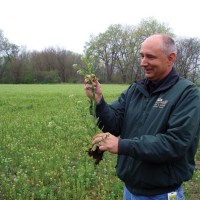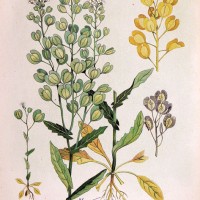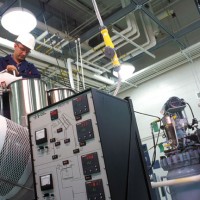Converting weeds into fuel
Ag Lab Chemists Finding Good Uses for Pennycress and Other Crops
From quiet fields to high powered jet fuel, there is a new “field to flight” path being created for redesigned camelina, mustard, and rapeseed/canola crops.
Led by a scientist at the Peoria Ag Lab, the research project is part of a broad effort to use renewable resources in gaining American energy independence. It is funded by a $7 million grant from the U.S. Departments of Agriculture (USDA) and Energy (DOE).
Fuels have become the single largest operational cost to the airline industry and military and renewable fuels can significantly reduce greenhouse gas emissions. Hydrotreated renewable jet fuels from plant oils have been commercially demonstrated and certified for aviation use, but full-scale production has not occurred because pricing is not competitive with petroleum fuels.
While hydrotreated renewable jet fuels can help meet air transportation needs for alternative fuels, secure and stable fuel sources are required for economic sustainability. Meanwhile, significant fuel purchasers provide a strong market pull to help develop complete supply chains to meet their needs.
The Peoria Ag Lab, formally known as the National Center for Agricultural Utilization Research (NCAUR), is part USDA’s in-house research agency, the Agricultural Research Service. The research service has strength in building interdisciplinary teams and coordinating nation-wide networks of scientists, facilities, stakeholders and industry cooperators.
Terry Isbell, a research chemist at NCAUR and principle director for the hydrotreated renewable jet fuel project, has led multiple research groups both inside and outside of the Agricultural Research Service. He has also been heavily involved with industry and intermediaries on an ongoing basis. His current research includes developing advanced biodegradable engine lubricants known as estolides and developing pennycress — a plant from the mustard family —that he discovered to have high potential as an energy crop. Pennycress is currently being developed for use as biodiesel.
“I was walking through a field one day, picked up some pennycress and wondered how much oil would be in those tiny seeds,” he said. “So I brought it back to the lab and tested it; turned out the seeds had a higher percentage of oil than soybeans.”
That knowledge took on new significance as interest in biodiesel grew along with the increase in petroleum prices. The primary source for biodiesel is soybeans, but a debate was underway: Should soybeans be used for food or for fuel?
“It was a problem almost custom-made for pennycress to solve,” Isbell noted.
An energy crop with no food value, pennycress sidesteps the food vs. fuel debate. Added to the crop rotation between corn and soybeans, it generates additional income for growers. Yielding nearly clear oil that requires limited refining, it is highly attractive for conversion to biodiesel.
The pennycress research project includes collaboration with geneticists, plant breeders, universities and private sector companies in an effort to turn a weed into an income-generating domestic crop with a future as a biofuel. This year 500 acres were harvested; next year there will be 1,500 acres in commercial production.
“There is no lack of interest in this area of research,” Isbell said. “The scientific value of this jet fuel project is huge and working closely with this number of top people is very exciting.”
More than 20 principle investigators have been assembled from across the nation to conduct the four-year project, representing federal agencies, universities and the private sector, the Agricultural Research Service said.
The interdisciplinary team will address multiple supply chain barriers and work to establish a supply of high-quality feedstock to produce HRJ fuel at competitive prices. The expertise includes specialists in genetics, plant breeding, agronomy, chemistry, remote sensing technology, economics, rural sociology, market analysis, business development and technology commercialization, the research service said.
Establishing a supply of high-quality feedstock includes developing new lines of the oilseed crops designed for increased oil quality and yield and new strategies to expand production using remote sensing and crop modeling technologies. “Since no single region or crop variety can meet all of the needs for oilseed feedstocks across a diverse environment, the crops will be incorporated into several existing agricultural areas of the Western United States,” it said.
Central to the plan is aligning agriculture and other business interests to finance and construct biorefineries and to create value chains that result in biofuels that are competitively priced with petroleum-based fuels. As a result, the project is designed to optimize profits to growers where feedstock sourcing occurs, the crushing plants where raw oil is extracted and the biorefineries where fuel production takes place.
Uniquely, it also includes a strong outreach and commercialization component designed to identify and address the concerns of farmers and allied agricultural service providers.
As principle director of the large, complex interdisciplinary effort, Isbell said he is already thinking forward to the many scientific challenges to be addressed and blended and the multiple feedback loops required to optimize each phase of the project. Progress and results are monitored and evaluated every six months during the four-year period, including an assessment of the progress towards completing specific milestones, he added.
“This really isn’t a closed-end project,” he noted. “The next four years and the discoveries we make are really just the beginning of what will likely be long-term relationships and multiple spin-off projects. What we’re doing is laying the foundation for long-term impact; cost and performance competitive fuels from renewable resources, and a stronger rural economy.”
Kate O’Hara is NCAUR Deputy Director, External Relations. She is based at the Peoria Ag Lab.
Terry Isbell, a chemist at the Peoria Ag Lab, holds a stalk of pennycress. Once considered only a weed, pennycress is one of several plants that are now being turned into biofuels through a process developed at the Ag Lab.
Terry Isbell, left, and Steve Cermak, chemists at the Peoria Ag Lab, are shown working in the oilseed research pilot plant lab. The Ag Lab is formally known as National Center for Agriculture Utilization Research established by the U.S. Department of Agriculture.



